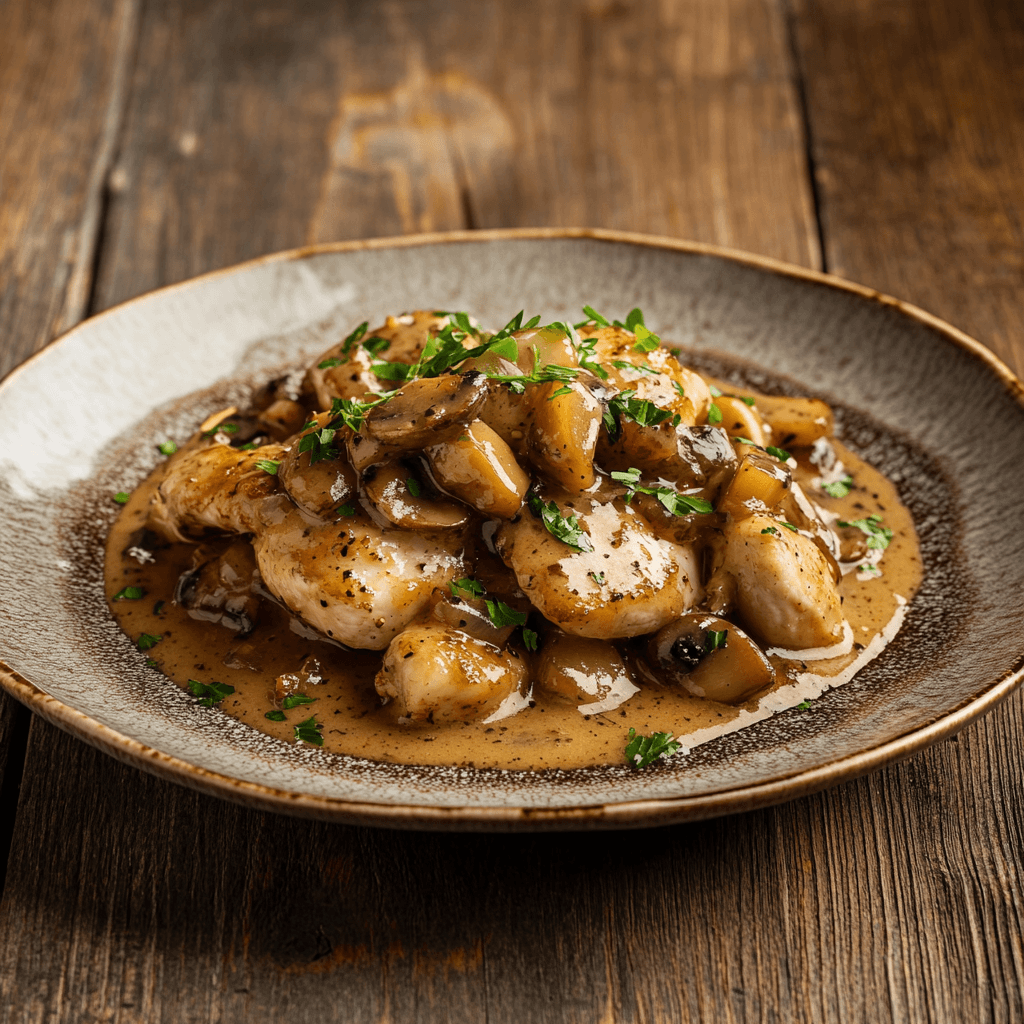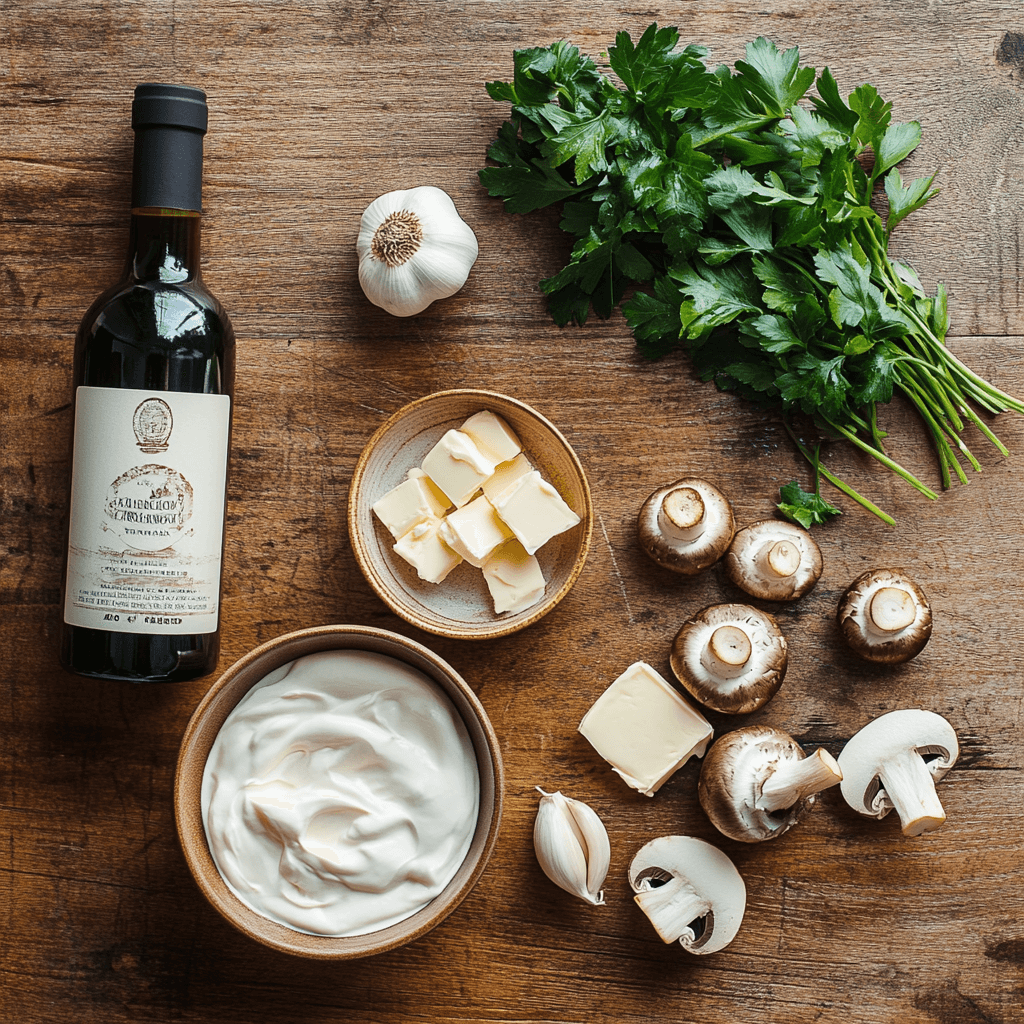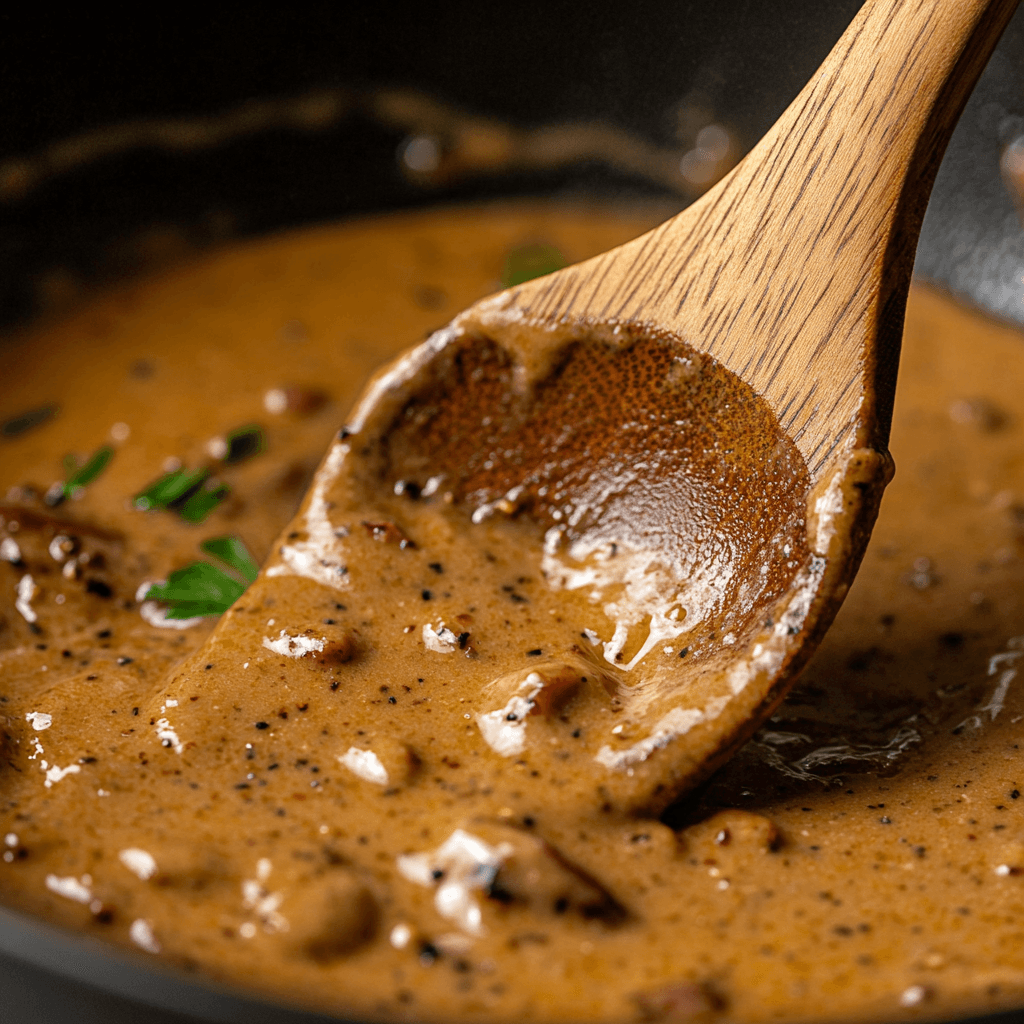
Marsala sauce is a luscious, savory, and slightly sweet sauce originating from Italian cuisine. It derives its name from Marsala wine, a fortified wine produced in the Marsala region of Sicily. Renowned for its versatility, Marsala sauce has become a favorite among home cooks and chefs for enhancing the flavor of meats, vegetables, and pasta dishes.
This rich sauce is celebrated for its creamy consistency and complex flavor profile. Often paired with proteins like chicken and veal, Marsala sauce is equally impressive in vegetarian dishes. Let’s delve into what makes up this beloved sauce and how it transforms everyday meals into gourmet experiences.
Table of Contents
Key Ingredients of Marsala Sauce

Marsala sauce is known for its balance of savory, sweet, and umami flavors. The combination of its ingredients creates a rich and creamy texture that pairs well with various dishes. Here’s a breakdown of the essential components that make Marsala sauce truly special:
Marsala Wine
At the heart of Marsala sauce lies Marsala wine, a fortified wine from Sicily. Its nutty and slightly sweet taste is what gives the sauce its signature flavor. Marsala wine comes in both dry and sweet varieties, with dry Marsala typically used for savory dishes like Marsala sauce.
- Flavor Contribution: Adds depth, sweetness, and complexity.
- Culinary Role: Acts as a deglazing agent, blending flavors from the pan into the sauce.
Butter and Olive Oil
The base of Marsala sauce often begins with a mix of butter and olive oil. These fats provide a rich and silky foundation for the sauce.
- Butter: Adds creaminess and a luxurious texture.
- Olive Oil: Balances the richness of butter and lends a subtle fruity note.
Garlic and Onions (or Shallots)
These aromatics are essential for creating a robust flavor base. Sautéed in the butter and oil, garlic and onions (or sometimes shallots) infuse the sauce with a fragrant and savory undertone.
- Garlic: Enhances umami and provides a slightly pungent kick.
- Onions/Shallots: Contribute sweetness and a delicate caramelized flavor.
Mushrooms (Optional)
While not always present, mushrooms are a popular addition to Marsala sauce. They soak up the flavors of the wine and broth, adding an earthy dimension to the dish.
- Types: Cremini or button mushrooms are common choices.
- Contribution: Boosts the umami profile and provides texture.
Broth or Stock
To dilute and deepen the flavor of the sauce, chicken, vegetable, or beef stock is often added. The broth complements the Marsala wine, ensuring the sauce isn’t overly sweet or overpowering.
- Purpose: Enhances the savory aspect and adds depth.
Flour or Cornstarch (for Thickening)
A light dusting of flour or a cornstarch slurry is sometimes used to achieve the desired consistency. This ensures the sauce clings beautifully to meats and vegetables.
- Flour: Provides a smooth and cohesive texture.
- Cornstarch: Used for a gluten-free option.
Marsala sauce is a delightful interplay of these ingredients, each contributing to its unique taste and texture. The next section will explore the pivotal role of Marsala wine and how it shapes the sauce’s flavor.
The Role of Marsala Wine
Marsala wine is the cornerstone of Marsala sauce, imparting its distinct flavor and aroma. Its history and production methods give it a unique profile that elevates the sauce, making it an essential ingredient. Let’s explore its characteristics and contributions in greater detail.
The Origins of Marsala Wine
- Fortification Process: Marsala wine is fortified with brandy, which enhances its alcohol content and preserves its flavor.
- Aging Levels: The wine is aged to varying degrees, with classifications such as Fine (minimum one year) and Superiore (minimum two years). The aging process contributes to its depth and complexity.
Sweet vs. Dry Marsala Wine
Marsala wine is available in both sweet and dry varieties, and the choice between the two can influence the final flavor of the sauce.
- Dry Marsala: Often used for savory dishes, it has subtle nutty and caramelized notes.
- Sweet Marsala: Occasionally incorporated for a richer, sweeter sauce, adding a more pronounced dessert-like flavor.
In traditional Marsala sauce, dry Marsala is preferred for its balance of sweetness and acidity, which complements the savory components of the dish.
How Marsala Wine Enhances the Sauce
Marsala wine is a culinary powerhouse that transforms the sauce into a multi-dimensional flavor experience. Its effects include:
- Deglazing the Pan: Marsala wine is used to deglaze the pan, lifting browned bits (fond) left from sautéed proteins or vegetables. These bits add a concentrated flavor to the sauce.
- Flavor Development: The wine’s notes of dried fruit, nuts, and caramel blend with the butter and cream, creating a harmonious balance.
- Aromatic Appeal: As the wine reduces, its alcohol content evaporates, leaving behind a fragrant aroma and a more concentrated flavor.
Substituting Marsala Wine
While authentic Marsala wine is ideal, there are substitutes for those who may not have it on hand or prefer not to use alcohol.
- Non-Alcoholic Options: Grape juice combined with a splash of balsamic vinegar can mimic the sweet and tangy aspects of Marsala wine.
- Other Wines: Dry sherry or Madeira wine can serve as a close substitute, though they slightly alter the flavor profile.
Traditional Variations of Marsala Sauce
Marsala sauce is versatile and adapts beautifully to different culinary traditions. While the base ingredients remain consistent, the addition of specific proteins, vegetables, or spices creates variations that cater to different tastes. Here are some popular traditional variations of Marsala sauce and their unique features.
Chicken Marsala
Chicken Marsala is one of the most recognized dishes featuring Marsala sauce. In this classic recipe, chicken breast or thighs are lightly coated in flour, pan-seared, and then simmered in Marsala sauce.
- Key Ingredients: Chicken, mushrooms, Marsala wine, garlic, cream, and fresh parsley.
- Cooking Method: After browning the chicken, Marsala wine is used to deglaze the pan, and the sauce is built with mushrooms, garlic, cream, and broth.
- Flavor Profile: A delightful combination of savory, earthy, and slightly sweet flavors.
Veal Marsala
Veal Marsala is another iconic Italian-American dish where tender veal cutlets are the star. The delicate nature of veal pairs exceptionally well with the richness of Marsala sauce.
- Key Ingredients: Veal, Marsala wine, mushrooms, butter, and fresh thyme or sage.
- Cooking Method: Thin veal cutlets are pan-fried until golden and then coated in a creamy, wine-infused sauce.
- Flavor Profile: Subtle and refined, with a balance of umami and sweetness.
Vegetarian Marsala
For those seeking a meat-free option, vegetarian Marsala focuses on hearty vegetables and plant-based ingredients.
- Common Variations:
- Mushroom Marsala: Mushrooms take center stage, absorbing the sauce’s rich flavors.
- Cauliflower or Eggplant Marsala: These vegetables are roasted or seared and then coated in the sauce.
- Cooking Method: The vegetables are sautéed or roasted, then combined with the sauce for a robust dish.
- Flavor Profile: Earthy and rich, with the Marsala wine elevating the natural sweetness of the vegetables.
Seafood Marsala
Though less traditional, Marsala sauce pairs surprisingly well with seafood, offering a unique twist to classic recipes.
- Key Proteins: Shrimp, scallops, or firm white fish like cod.
- Cooking Method: The seafood is lightly sautéed, then combined with a lighter version of Marsala sauce, often without cream to preserve the delicacy of the seafood.
- Flavor Profile: A sweet-savory balance, with a hint of brininess from the seafood.
Pasta with Marsala Sauce
For a more carb-centric option, Marsala sauce is sometimes served over pasta, either as the primary sauce or as an accompaniment to protein.
- Types of Pasta: Tagliatelle, fettuccine, or pappardelle work best for holding the creamy sauce.
- Additions: Grated Parmesan cheese and fresh herbs like parsley or thyme enhance the dish.
Pairing Marsala Sauce with Side Dishes
Marsala sauce variations are often paired with sides to create a complete meal. Some classic pairings include:
- Mashed Potatoes: Creamy mashed potatoes soak up the rich sauce beautifully.
- Rice Pilaf: A light and fluffy rice pilaf complements the sauce’s complexity.
- Roasted Vegetables: Roasted carrots, zucchini, or asparagus add a fresh contrast to the creamy sauce.
How to Make Marsala Sauce

Marsala sauce is surprisingly simple to make at home and can be customized to suit your taste. By following a step-by-step process, you can create this versatile sauce to accompany your favorite proteins or vegetables. Here’s a detailed guide to making a classic Marsala sauce.
Ingredients Needed
To prepare Marsala sauce, gather the following ingredients:
- Butter: 2 tablespoons, for richness.
- Olive Oil: 1 tablespoon, for balance and to prevent the butter from burning.
- Garlic: 2-3 cloves, minced.
- Shallots or Onions: 1 small shallot or half an onion, finely diced.
- Mushrooms: 1 cup, sliced (optional, but recommended for added flavor).
- Flour: 1 tablespoon, for thickening the sauce.
- Marsala Wine: 1/2 cup (preferably dry).
- Chicken or Vegetable Broth: 1 cup, for depth and dilution.
- Heavy Cream: 1/3 cup, for creaminess.
- Salt and Pepper: To taste.
- Fresh Parsley or Thyme: For garnish.
Step-by-Step Instructions
Sauté the Aromatics
- Heat a large skillet over medium heat.
- Add butter and olive oil. Once melted, add the minced garlic and shallots or onions.
- Cook for 2-3 minutes until fragrant and translucent, being careful not to burn the garlic.
Cook the Mushrooms
- If using mushrooms, add them to the skillet and sauté for 5-7 minutes until they release their liquid and become golden brown.
- Season with a pinch of salt and pepper to enhance the flavor.
Add the Flour
- Sprinkle the flour over the sautéed ingredients.
- Stir well to coat the mixture evenly, cooking for about 1 minute to eliminate the raw flour taste.
Deglaze with Marsala Wine
- Slowly pour in the Marsala wine, stirring constantly to deglaze the pan.
- Scrape up any browned bits from the bottom of the pan, as these add flavor to the sauce.
Simmer the Sauce
- Add the chicken or vegetable broth to the skillet, stirring to combine.
- Let the sauce simmer gently for 8-10 minutes, allowing it to reduce and thicken slightly.
Finish with Cream
- Reduce the heat to low and stir in the heavy cream.
- Cook for an additional 2-3 minutes, ensuring the sauce is smooth and velvety.
Adjust Seasoning and Garnish
- Taste the sauce and adjust the seasoning with salt and pepper as needed.
- Sprinkle with fresh parsley or thyme for a burst of freshness.
Tips for Customization
- For a Gluten-Free Version: Use cornstarch instead of flour for thickening.
- To Intensify the Flavor: Add a splash of balsamic vinegar for extra depth.
- For a Lighter Sauce: Omit the cream and rely on the reduced Marsala wine and broth for a thinner, more concentrated sauce.
Serving Suggestions
Marsala sauce is highly adaptable and pairs wonderfully with various dishes. Some serving ideas include:
- Drizzle over pan-seared chicken breasts or veal cutlets.
- Toss with pasta for a luxurious meal.
- Serve as a topping for roasted vegetables or mashed potatoes.
Tips for Perfect Marsala Sauce
Creating the perfect Marsala sauce requires attention to detail and a few key techniques. These tips will help you enhance its flavor, achieve the ideal consistency, and create a dish that tastes like it’s from a fine dining restaurant.
Choosing the Right Ingredients
Marsala Wine Quality Matters
The quality of the Marsala wine you use significantly impacts the final flavor of your sauce.
- Choose Authentic Marsala Wine: Opt for a high-quality dry Marsala wine, preferably imported from Sicily.
- Avoid Cooking Marsala: Marsala labeled specifically for cooking often contains added salt and lower-quality ingredients, which can affect the taste.
Fresh Ingredients for Better Flavor
Using fresh, high-quality ingredients like garlic, onions, mushrooms, and cream ensures the best results.
- Butter and Olive Oil: Use unsalted butter for better control of the seasoning, and extra virgin olive oil for added richness.
- Mushrooms: Fresh cremini or button mushrooms provide a firm texture and deep, earthy flavor.
Mastering the Cooking Technique
Sauté Aromatics Properly
To build a strong flavor foundation, sauté the garlic, onions, or shallots until they are fragrant and lightly golden.
- Tip: Use medium heat to prevent burning, which can make the sauce bitter.
Deglazing the Pan
Deglazing with Marsala wine is a crucial step for incorporating the caramelized bits (fond) from the bottom of the pan into the sauce.
- Technique: Add the wine while the pan is still hot, and use a wooden spoon to scrape up the flavorful bits.
Simmering for Flavor Development
Let the sauce simmer gently after adding the wine and broth. This reduces the liquid, concentrating the flavors for a richer taste.
- Ideal Simmering Time: 8-10 minutes, or until the sauce thickens slightly.
Heading 3: Achieving the Perfect Consistency
Thickening the Sauce
To achieve a creamy and cohesive texture, thickening agents like flour or cornstarch can be used.
- Flour: Add a tablespoon early in the cooking process and stir well to avoid lumps.
- Cornstarch Slurry: Mix 1 teaspoon of cornstarch with 2 teaspoons of water, then stir into the simmering sauce as needed.
Balancing the Cream
Adding cream too early can cause it to curdle.
- Tip: Stir in the heavy cream at the very end, over low heat, to maintain its smooth texture.
Balancing Flavors
Marsala sauce is a harmonious blend of savory, sweet, and umami flavors. Proper balance is essential to avoid an overly sweet or bland sauce.
- Sweetness from Marsala Wine: If the sauce is too sweet, add a splash of lemon juice or balsamic vinegar to counterbalance it.
- Seasoning: Taste the sauce before serving and adjust the salt and pepper accordingly.
Enhancing the Presentation
A beautifully presented dish enhances the dining experience.
- Garnish: Sprinkle freshly chopped parsley, thyme, or grated Parmesan over the finished dish for a pop of color and flavor.
- Plating: Serve Marsala sauce over proteins, vegetables, or pasta, and pair with vibrant side dishes like roasted vegetables or a crisp salad.
Common Mistakes to Avoid
Using the Wrong Wine
Avoid substituting Marsala wine with overly sweet or low-quality cooking wines. These can overpower the sauce and detract from its depth.
Skipping the Deglazing Step
Failing to deglaze the pan can result in a sauce that lacks the complexity of flavor from the caramelized bits.
Over-Thickening the Sauce
Adding too much flour or cornstarch can lead to a gloopy consistency. Adjust thickening agents gradually.
Frequently Asked Questions (FAQs)
Marsala sauce often raises questions, particularly for those new to its preparation or looking to adapt it to specific dietary needs. Here are answers to some of the most commonly asked questions about this versatile sauce.
Can I Make Marsala Sauce Without Marsala Wine?
Yes, while Marsala wine is the key ingredient that gives the sauce its signature flavor, substitutions can be used in a pinch.
- Non-Alcoholic Options: A mix of grape juice and balsamic vinegar can mimic the sweet and tangy notes of Marsala wine.
- Alcoholic Substitutes: Dry sherry or Madeira wine are the closest alternatives, though they will slightly alter the flavor profile.
Is Marsala Sauce Gluten-Free?
Marsala sauce can be made gluten-free by replacing all-purpose flour with cornstarch or a gluten-free flour blend.
- Tip for Thickening: Create a cornstarch slurry (1 teaspoon cornstarch mixed with 2 teaspoons of water) and add it to the simmering sauce to thicken.
Can I Make a Dairy-Free Version of Marsala Sauce?
Absolutely! Marsala sauce can be adapted for those avoiding dairy by substituting cream and butter with plant-based alternatives.
- Dairy-Free Substitutes:
- Use coconut cream or almond milk for creaminess.
- Replace butter with olive oil or vegan butter.
- Flavor Tip: Add a pinch of nutritional yeast to mimic the savory richness of cream.
What Dishes Pair Best with Marsala Sauce?
Marsala sauce is highly versatile and pairs well with a variety of dishes:
- Proteins: Chicken, veal, pork chops, or seafood like shrimp and scallops.
- Vegetarian Options: Mushrooms, roasted cauliflower, or eggplant.
- Carbs: Serve it over pasta, rice, or mashed potatoes for a hearty meal.
How Do I Store and Reheat Marsala Sauce?
Marsala sauce can be stored and reheated, making it a convenient option for meal prep.
- Storage: Keep the sauce in an airtight container in the refrigerator for up to 3 days.
- Reheating: Warm the sauce gently on the stovetop over low heat, stirring occasionally. If it thickens too much, add a splash of broth or water to adjust the consistency.
Can Marsala Sauce Be Frozen?
Yes, Marsala sauce freezes well, though sauces with cream may slightly separate upon thawing.
- Freezing Instructions:
- Cool the sauce completely before transferring it to a freezer-safe container.
- Freeze for up to 2 months.
- Thawing and Reheating: Defrost in the refrigerator overnight and reheat slowly, stirring frequently to recombine the ingredients.
Is Marsala Sauce Keto-Friendly?
- Keto Substitutions:
- Use heavy cream and butter for richness.
- Replace flour with almond flour or xanthan gum for thickening.
- Carb Count: Be mindful of the natural sugars in Marsala wine and adjust portion sizes accordingly.
Conclusion
Marsala sauce is a culinary gem that combines the rich flavors of Marsala wine, cream, and savory aromatics to create a versatile and indulgent dish. Its Italian roots and global adaptations make it a favorite for both traditional and modern cuisine.
Whether served with chicken, veal, or a vegetarian option, Marsala sauce enhances meals with its complexity and balance. By following the tips and techniques shared in this guide, you can create your own version of this classic sauce, tailored to your preferences and dietary needs.
From comforting family dinners to elegant dinner parties, Marsala sauce remains a timeless choice for elevating any dish.
